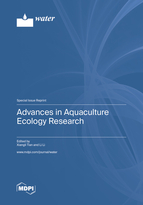Advances in Aquaculture Ecology Research
A special issue of Water (ISSN 2073-4441). This special issue belongs to the section "Water, Agriculture and Aquaculture".
Deadline for manuscript submissions: closed (15 October 2022) | Viewed by 21728
Special Issue Editors
Interests: aquaculture ecology; aquatic microbial ecology; probiotics for aquaculture
Special Issue Information
Dear Colleagues,
Worldwide demand for aquatic products is growing due to population growth and increased fish consumption, and this demand is expected to increase by 57% between 2005 and 2050 (FAO, 2014). However, aquaculture faces environmental challenges in its efforts to increase both the quantity and quality of production without increasing the negative externalities. Aquaculture ecology belongs to the category of applied ecology. It is the science of the interaction between environment and commercial aquatic organisms as well as their farming activities, and the principles for the establishment and management of aquaculture systems. Its basic goal is to provide a theoretical basis and key technical supports for the sustainable development of aquaculture industry, i.e., to protect the ecological environment of farming waters, rationalize the use of resources, and improve economic efficiency. Aquaculture ecology is closely related to the development of the aquaculture industry. On one hand, the technicalization of its theoretical achievements can correspondingly promote the development of the aquaculture industry; on the other hand, its development is strongly driven by the expansion of the industrial scale and the increase in farming species. For this Special Issue of Water, manuscripts (original research and reviews) are solicited that describe advances in individual ecology of commercial aquatic organisms, ecology of aquaculture systems, interaction between aquaculture activities and the environment, structure of function of the microbial community, principles of environment management in aquaculture ecosystems, etc. in recent decades.
Prof. Dr. Xiangli Tian
Prof. Dr. Li Li
Guest Editors
Manuscript Submission Information
Manuscripts should be submitted online at www.mdpi.com by registering and logging in to this website. Once you are registered, click here to go to the submission form. Manuscripts can be submitted until the deadline. All submissions that pass pre-check are peer-reviewed. Accepted papers will be published continuously in the journal (as soon as accepted) and will be listed together on the special issue website. Research articles, review articles as well as short communications are invited. For planned papers, a title and short abstract (about 100 words) can be sent to the Editorial Office for announcement on this website.
Submitted manuscripts should not have been published previously, nor be under consideration for publication elsewhere (except conference proceedings papers). All manuscripts are thoroughly refereed through a single-blind peer-review process. A guide for authors and other relevant information for submission of manuscripts is available on the Instructions for Authors page. Water is an international peer-reviewed open access semimonthly journal published by MDPI.
Please visit the Instructions for Authors page before submitting a manuscript. The Article Processing Charge (APC) for publication in this open access journal is 2600 CHF (Swiss Francs). Submitted papers should be well formatted and use good English. Authors may use MDPI's English editing service prior to publication or during author revisions.
Keywords
- ecophysiology of commercial aquatic organisms
- water quality
- structure and function of microbial community
- ecological model
- aquaculture environment interactions
- environment management
- aquaculture ecosystems
- sustainability of aquaculture systems







